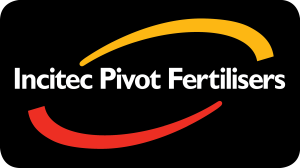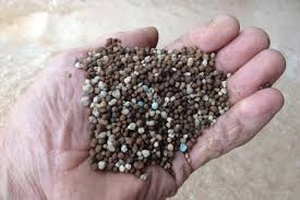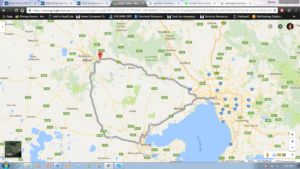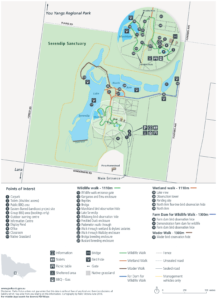Itinerary
| 7:45am | Meet outside Gate 3 at the Melbourne Cricket Ground (MCG) |
| 8:00am | Depart the MCG via coach and travel to PGG Wrightson Seeds |
| 9:30am | Arrive at PGG Wrightson Seeds |
| 10:30am | Depart PGG Wrightson Seeds for Southern Farming Systems |
| 11:30am | Arrive at Southern Farming Systems, Inverleigh |
| 12:00pm | BBQ lunch and inspection of trails |
| 1:15pm | Depart Southern Farming Systems for Incitec Pivot Fertilisers |
| 1:45pm | Arrive Incitec Pivot Fertilisers |
| 2:45pm | Depart Incitec Pivot Fertilisers to Serendip Wildlife Sanctuary |
| 3:00pm | Arrive Serendip Wildlife Sanctuary |
| 4:00pm | Depart Serendip Wildlife Sanctuary for MCG |
| 5.30pm | Arrive Melbourne Cricket Ground, MCG |
PGG Wrightson Seeds Research Farm - Ballarat
PGG Wrightson Seeds research farm – Ballarat
Martin Harmer
Overview of operations at PGG Wrightson Seeds research farm at Ballarat
Lee Menhenett
Joint research trial looking at N requirements in ryegrass varieties – comparing older genetic material with modern highly productive varieties – has the N requirement changed?
The Leigh Creek Research station, located on the outskirts of Ballarat, Victoria, is the centre of the research and extension activities for PGG Wrightson Seeds and its subsidiary brands in Australia. The Centre is situated on 24 hectares of land, mostly set-up for small-plot evaluation using stringent research protocols to ensure all trials are conducted to the highest standard of quality and accuracy. The extensive regional trial programme is supported and coordinated from Ballarat and tests all of the elite candidate varieties and commercial lines in true on-farm evaluation trials around the country, subjecting them to a range of local environmental conditions.

Variety response to N fertiliser
Incitec Pivot Fertilisers (IPF) initiated a research trial with PGC Wrightson Seeds in May 2014 to study response of a range of perennial ryegrass cultivars to nitrogen fertilisation. The cultivars include:
- Victorian perennial
- Fitzroy
- Aberdart
- One50
- Ultra
- Base nil
- Base AR37
- Experimental PGC Wrightson variety
This represents the genetic progression of ryegrass cultivars commonly used in southern Australia grazing systems with Victorian perennial ryegrass still forming the base of many sheep and beef pastures while more elite varieties like Base AR37 are more typically adopted by dairy farmers.
The experimental treatments comprise:
- 5 N rates (0, 20, 40, 80 & 160 kgN/ha) applied every second dry matter cut to all 8 varieties
- 4 N rates (0, 20, 40 & 80 kgN/ha) applied every dray matter cut to Vic Perennial and Base AR37
- A comparison at the 40 kgN/ha of Green Urea NV® (urea treated with a urease inhibitor) with conventional urea
Measurements include dry matter cuts, tissue total N & soil mineral N analysis at 10 cm increments to 30 cm.
Results
To date the trial has demonstrated differences in optimal N rate strategies across seasons with recommended strategies being similar during autumn and spring for most varieties, but very different in summer and autumn where elite varieties still have good dry matter yield potential, but more traditional varieties are either dormant or slow growing.
This trial has challenged accepted nitrogen management strategies and application rates in southern Australia suggesting that there are certain times of the year when it is both economically and agronomically viable to exceed current recommended N guidelines of 25-60 kgN/ha/application
Southern Farming Systems - Inverleigh
Southern Farming Systems – Inverleigh
Jon Midwood
SFS – overview of operations, key local issues and N research projects. Opportunity to inspect trials, machinery and operations
Southern Farming Systems was formed by six founding members in 1995 to investigate ways of improving the profitability of cropping systems in the high rainfall zone of western Victoria. Since its formation, SFS has expanded geographically to eastern Victoria and Tasmania and now has 500 members. Aside from addressing the challenge of cropping on poorly drained (often water logged) duplex soils in a cool wet environment, SFS has also addressed challenges associated with pests like slugs and snails, strategies to combat herbicide resistance weeds like annual ryegrass, canopy management, WUE and integration of livestock into productive cropping systems.
The Inverleigh site is one of a number of hubs that SFS has across it’s footprint and is currently hosting a number of trials of wheat, barley, canola and beans. The aim will be to look at a couple of nitrogen response trials in wheat and barley and an overview of the NVT (National variety trials) which are on the SFS Inverleigh site.
Malcolm McCaskill; Aaron Vague SFS
One of the projects hosted by SFS is led by Dr Malcolm McCaskill, a Soil and Water scientist with Agriculture Victoria in Hamilton, with responsibility for the nutrient component of a GRDC / Agriculture Victoria project “Optimising Crop Production in the HRZ”. This project is testing the hypothesis that critical soil test levels developed in the low and medium rainfall areas of Australia are too low for the high rainfall zone (HRZ). In this region, potential yields are as high as 10 t/ha for wheat and 7 t/ha for canola. The project also has current trial sites at Hamilton, Tarrington and Rutherglen in Victoria, and Bool Lagoon in South Australia. Malcolm also has responsibilities within projects on nitrogen and waterlogging in wheat, and modelling of baking quality in wheat. His undergraduate degree in Rural Science was undertaken at the University of New England in Armidale, New South Wales, where he also completed a Masters and PhD in mineral nutrition of pastures.
Omission trial design, showing the combination included treatments as “Y”. ‘All’ refers to all nutrients (P, K, S, Cu and Zn) minus (-) individual nutrients. Nutrient application rates for the “all” treatment are 50 kg P/ha, 50 kg K/ha, 20 kg S/ha, 1.1 kg Zn/ha and 2 kg Cu/ha.
| N rate | Treatment | |||||
| Nil | All-P | All-K | All-S | All -Cu & -Zn | All | |
| Low (30 kg N/ha) | Y | Y | ||||
| Medium (64 kg N/ha) | Y | Y | Y | Y | Y | Y |
| High (236 kg N/ha) | Y | Y | Y | Y | Y | Y |
Background soil test values at the Inverleigh site, and critical levels and confidence range (70%) for wheat from the Better Fertiliser Decisions database (November 2016) for Victoria (N and P), and Australia (K and S).
| Nutrient | Values at Inverleigh site (May 2016) | Critical level (90% relative yield) |
| N (nitrate + ammonium, kg/ha, 0-60 cm) | 173 | 82 (65-100) |
| P (Colwell, mg/kg 0-10 cm) | 84 | 24 (22-28) |
| K (Colwell, mg/kg 0-10 cm) | 290 | 69 (62-76) |
| S (KCl-40, mg/kg 0-10 cm) | 12.5 | 4.5 (3.2-6.4) |
The crop of Beaufort wheat was sown 31 May 2016. At a vegetative harvest 7 November, fresh weights showed a 17% response to extra N between the low and medium N rates, and a 6% response to extra K.
Incitec Pivot Fertilizers
Incitec Pivot Fertilisers– Geelong
Lee Menhenett
Overview of Incitec Pivot operations
Incitec Pivot Limited is a global fertiliser, explosives and industrial chemicals manufacturer and distributor listed on the Australian stock exchange. The fertiliser division manufactures ammonium phosphate fertilisers at Phosphate Hill in North West Queensland, nitrogenous fertilisers in Brisbane and superphosphate at Geelong and Portland in Victoria. IPF distributes around 2 million tonnes of fertiliser domestically through port facilities along the eastern and southern Australian coast line with Geelong a major distribution point for highly productive agriculture in Victoria and southern NSW. Aside from manufacturing Superfect®, a high quality superphosphate, the Geelong facility distributes a range of high quality “straight” fertilisers including MAP, DAP, urea, MOP, SOP, ammonium sulphate, Nitrophoska, urea ammonium nitrate, calcium ammonium nitrate and a range of trace elements. IPF also manufactures / formulates enhanced efficiency nitrogen fertilisers in Geelong including Green Urea NV® and Entec® stabilised fertilisers.



Serendip Sanctuary
Serendip Sanctuary
Self-guided boardwalk
Serendip Sanctuary is a 227 ha protected area in Victoria, Australia, near the You Yangs and the town of Lara, some 22 km north of Geelong and 60 km south-west of Melbourne.
Originally used for farming and other purposes, it was purchased in 1959 by the state government of Victoria for wildlife research and the captive management and breeding of species threatened in Victoria, such as the brolga, magpie goose, Australian bustard, and bush stone-curlew.
Serendip now focuses more on environmental education about the flora and fauna of the wetlands and open grassy woodlands of the volcanic Western Plains of Victoria. It was opened to the public in 1991 and is now managed by Parks Victoria.
The sanctuary, an excellent example of the open grassy woodlands and wetlands of the volcanic Western Plains, is the perfect place to learn about and experience birdlife and wetlands ecology.
The sanctuary contains many different types of wetland and is home to many plant species as well, such as river red gums, tall spikerush, and tussock grass.
See some of the 150 species of birds which breed at or visit Serendip Sanctuary from the bird hides. Birds can be seen within metres of the viewing areas preening, feeding, incubating eggs and rearing young.
The Wildlife Walk is a popular walk offering close encounters with wildlife. Meander past emus and Eastern Grey Kangaroos grazing to viewing areas, hides and flight aviaries perfect for bird watching. You may be treated to Brolgas trumpeting, Whistling Kites soaring high overhead, magnificent Yellow-billed Spoonbills wading through the shallow water, or even a glimpse of the well hidden Tawny Frogmouth as it watches you pass by.





